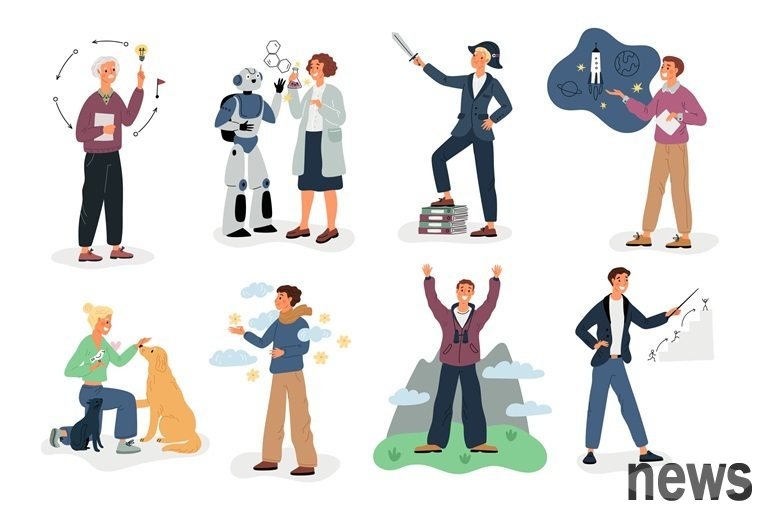
Have you ever heard someone describe themselves as INTJ or ESTP type and are curious about what these mysterious letters might mean? These four letter codes are possible results of personality assessments from a series of questions called Myers-Briggs Type Indicator (MBTI), a psychological tool that has been around for more than 75 years. Therefore, these people describe their personality types based on MBTI.
What is MBTI test?Mils-Briggs Type Index (MBTI) is a self-reported question paper, which helps people evaluate their personality using four specific dichotomies or scales: introvert-extrovert, perceptual-intuitive, thinking-sensory and judgment-perception.
MBTI was originally created by Isabel. Briggs. Isabel Briggs Myers and her mother Ketherine. Kuk. Katharine Cook Briggs is based on psychologist Carr. Carl Jung's psychological typology theory was proposed in the 1940s.
According to the Miles and Briggs Foundation, the purpose of the test is to make the psychological typology theory described by Rong Ge easily understands and plays a role in people's lives. In other words, MTBI aims to clearly and understand a person's personality type in a practical way.
Based on the answers to a series of questions, people are recognized as having one of 16 personality types. The goal of MBTI is to allow visitors to further explore and understand their personality, including preferences, dislikes, advantages, disadvantages, possible career preferences, and compatibility with others.
No personality type is "best" or "better" than the other personality type. It is not a tool designed to find dysfunction or abnormalities. Instead, its goal is just to help you learn more about yourself.
How to perform MBTI test?MBTI test is a self-reported personality assessment. During the test period, individuals answered about 90 questions ranging from above to below and evaluated their preferences for four different dichotomies: inward-outward, perception-intuitive, thinking-perception and judgment-perception. According to their answers, MBTI classified it into one of 16 different personality types based on personal self-report preferences and behaviors.
. Extroversion-inward is represented by E or I. Feeling-direction is represented by S or N
. Thinking-feeling is represented by T or F
. Determination-perception is represented by J or P
extroversion (E)– inward (I)This scale describes how people react and interact with the surrounding world. Extroverts tend to be action-oriented, enjoy more frequent social interactions, and feel energetic after spending time with others. Introverts tend to be thought-oriented, enjoy in-depth and intentional social interactions, and feel energetic after being alone.
Our preference for outward or inward influence:
. How do we charge after the day is over.. How we meet.
. We like the work environment.
. When we start executing a task.
. Our interests and hobbies.
Sensory(S)–Sensory(N)This scale involves looking at how people collect information from the world around them. People who like perception tend to pay great attention to reality, especially what they can learn from their senses. They tend to focus on facts and details, and enjoy practical experience. Those who like straightforwardness pay more attention to things like patterns and impressions. They like to think about possibilities, imagine the future, and abstract theories.
Our preferences for perception or direct influence:
. How do we view things.. What kind of instructions do we like?
. We learn how to learn new things.
. The information we need before buying.
. Our reaction to changes.
Think (T)– Feel (F)The focus of this scale is on how people make decisions based on the information collected from perceptual or direct functions. People who like to think pay more attention to facts and objectivity. When determining the rights, they tend to be consistent, logical and not personal. Those who like feelings are more likely to consider people and emotions when deriving conclusions.
Our preferences for the influence of thinking or perception:
. Our decision process - we first consider what we consider, secondly, etc.. Our help style.
. How do we offer feedback to people.
. Our approach to dealing with different views.
. How we want to be recognized or praised.
Discrimination (J)– Perception (P)This scale involves how people tend to deal with the outside world. Those who tend to be judged prefer structure and determined decisions. People who tend to perceive are more open, flexible and adaptable. These two directions interact with other scales.
Our preference for discriminating or perceived effects:
How we deal with complex tasks.When we are about to end.
How do we deal with deadlines.
How do we view work and entertainment.
How do we plan activities.

According to the Miles and Briggs Foundation, when each preferred letter is combined, 16 different personality types will be formed, including different characteristics unique to the type.
The following are the characteristics of each personality type:
ISTJ: introversion, perception, thinking, judgment. It is often more peaceful and strict.
. Seek truthfulness, responsibility, and practicality.
. Success through reliability and complete success.
. Enjoy order and organization.
ISFJ: Introversion, perception, perception, judgment. Calm and serious.
. Committed to fulfilling duties.
. Be kind, be loyal and consider others' feelings.
. Focus on the order and harmony of the family and work environment.
INFJ: Inward, direct, sensation, verdict. Careful to serve the public interest.
. An action that has insight and desires to understand others.
. Towards seeking meaning and connection in relationships and ideas.
. Dedicated to their value.
INTJ: Introvert, straightforward, thinking, judgment. People with original ideas are motivated to realize their goals.
. Identify event patterns to determine the perspective.
. Stubborn and independent.
. Keep high standards for yourself and others.
ISTP: introvert, perceive, think, perceive. Peaceful, sensitive, and kind.
. Dedicated to their value and people who are important to them.
. Like to work independently and follow your own steps.
. A malice conflict.
ISFP: inward, perception, perception, perception. Beautiful, flexible, and logical.
. Quickly find feasible solutions to the problem.
. Interested in causal relationships.
. Focus on efficiency.
INFP: Inward, direct, sensation, perception. Idealism, curiosity and adaptability.
. Be loyal to their value and people who are important to them.
. Desire to understand others and help them fully exert their potential.
. Seek a life that suits their value.
INTP: Introvert, direct, thinking, perception. Theory, analysis and doubt.
. Interested in providing logical explanations for things you are interested in.
. Focus on creativity rather than social interaction.
. Problem solver.
ESTP: Extroversion, perception, thinking, perception. Develop, live in the present.
. When solving problems, prefer action rather than theoretical explanations.
. Enjoy the beauty and comfort of the materials.
. Learn side by side.
ESFP: Extroversion, perception, thinking, perception. Like to work with others.
. Self-developed and easy to adapt to new people and environments.
. Real, outgoing, accepting.
. Learn the best when trying new skills with others.
ENFP: Extroversion, directness, perception, perception. Hot, passion, imaginative.
. Desire to be recognized by others.
. Desire to provide praise and support.
. Self-development, flexibility, and ability to develop immediately.
ENTP: Extroversion, directness, thinking, perception. Be smart, speak frankly, and inspire people.
. Solve problems with wisdom.
. Good at reading and understanding others.
. I think routine is boring and I often find new ways to do things.
ESTJ: Extrovert, perception, thinking, judgment. Be practical, decisive, organized.
. Values achieve results in the most effective way.
. Execute plans and decisions quickly and vigorously.
. Keep yourself and others clear and logical standards.
ESFJ: Extroversion, perception, perception, judgment. Cooperate, be honest, and be kind.
. Pay attention to the harmony of the environment.
. I hope to thank them for their contributions.
. Like to cooperate with others and complete tasks efficiently and accurately.
ENFJ: Extroversion, directness, perception, judgment. Be empathetic, responsible, loyal.
. Applicable to others' emotions, needs and motors.
. Usually used as a catalyst for personal and community growth.
. Extremely positive should be praised and criticized.
ENTJ: Extroversion, directness, thinking, judgment. Like long-term planning and goal settings.
. Usually, news, blogs and desire to share knowledge with others.
. Proficient problem solver.
. Be happy to develop a leadership role and share your thoughts vigorously.
How to find out your MBTI personality type?To determine your MBTI personality type, you need to fill out the MBTI question paper, and you can access the official test provided by MBTIonline.com, but the test on this website requires a fee.
However, you can also perform in other unofficial MBTI tests, such as the Free Personality Test free test provided by British company NERIS Analytics Limited. After completing several questions, you can get your own MBTI test results.
Next:Is it effective to bury the wire and moxibustion to reduce fat? Nutritionists teach you how to do something that can reduce the heat by 500 cards per day